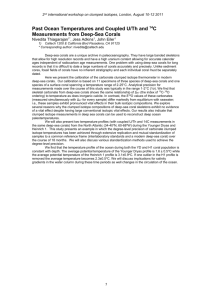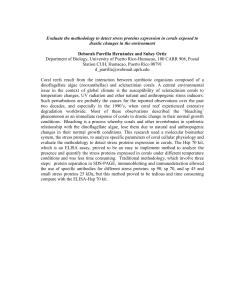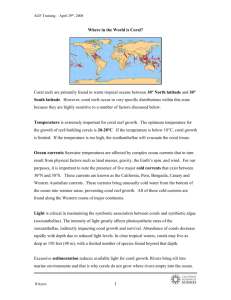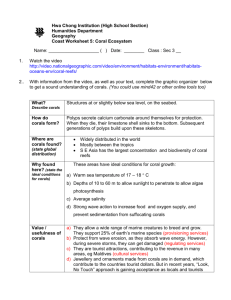Students will graph past sea level data obtained
advertisement
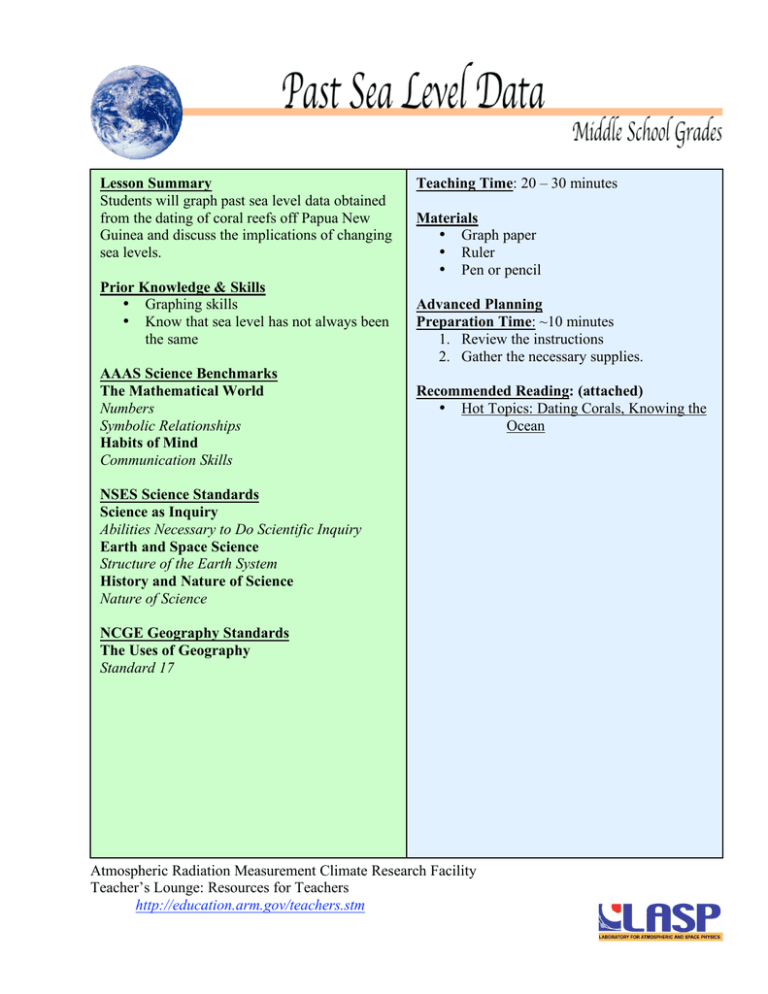
Lesson Summary Students will graph past sea level data obtained from the dating of coral reefs off Papua New Guinea and discuss the implications of changing sea levels. Prior Knowledge & Skills • Graphing skills • Know that sea level has not always been the same AAAS Science Benchmarks The Mathematical World Numbers Symbolic Relationships Habits of Mind Communication Skills Teaching Time: 20 – 30 minutes Materials • Graph paper • Ruler • Pen or pencil Advanced Planning Preparation Time: ~10 minutes 1. Review the instructions 2. Gather the necessary supplies. Recommended Reading: (attached) • Hot Topics: Dating Corals, Knowing the Ocean NSES Science Standards Science as Inquiry Abilities Necessary to Do Scientific Inquiry Earth and Space Science Structure of the Earth System History and Nature of Science Nature of Science NCGE Geography Standards The Uses of Geography Standard 17 Atmospheric Radiation Measurement Climate Research Facility Teacher’s Lounge: Resources for Teachers http://education.arm.gov/teachers.stm Thousands of Years Before Present 0 10 20 30 40 50 60 70 80 90 100 110 120 130 140 150 160 170 180 190 200 210 220 230 240 250 Meters Below Present Sea Level 0 23 119 54 44 72 55 71 22 59 20 48 27 5 16 123 111 30 57 87 46 32 7 25 12 32 Dive and Discover : Hot Topics : Dating Corals, Knowing the Ocean Home Choose an Expedition Dive into Deeper Discovery 07/25/2007 12:47 PM For Teachers Search Hot Topics: Dating Corals, Knowing the Ocean Hot Topics Hydrothermal Vents Godzilla, Sasquatch, and Homer Simpson: The Curious Names of Deep-sea Features Bacteria at Hydrothermal Vents Looking for Microbes Biogeography of Hydrothermal Vents Seafloor Geology Seafloor Gravity Seafloor Magnetics Lava Flows What Does a Young Submarine Lava Flow Look Like? Hotspots & Cool Volcanoes: The New England Seamounts Extreme Creatures Deep Sea Biology Galápagos Animal and Marine Life Seabird Observations in the Western Galápagos Islands Deep-Sea Corals Locating corals in the deep ocean and retrieving them presents all sorts of challenges. But once they’re on board, Print page Email to friend what good are they? For Expedition 7, much of the corals’ value lies in what they can tell us about the past -- recalling that history presents its own set of challenges. In order to know anything about past climate from corals, we need to know their age. Ordinarily, scientists determine an object’s age by measuring the radioactive decay of some element in it. Radioactive decay occurs when an unstable form of that element changes into a stable one by spinning off a part of its nucleus. Carbon is a useful element for dating objects because it’s so prevalent in our environment. The unstable form, or isotope, of carbon is 14C; its stable, unchanging isotope is 12C, where the different numbers refer to different atomic weights. As 14C decays, the ratio of 14C to 12C changes over time. This change allows us to measure age. The uranium-thorium “age” of a coral is the age of the coral. The radiocarbon (14C) “age” of the coral is the age of the coral, plus the age of the water in which it grew. Subtracting the former from the latter gives the age of the water in which it grew. Scientists use this information to learn about the rates at which water circulates through the oceans. We measure the rate of radioactive decay with what’s called a half-life. 14C’s half life is 5,730 years. This means that every 5,730 years, there’s half as much 14C as there was in the previous 5,730-year period. To extend this concept, in 11,460 years, there’s one-fourth the amount of 14C as there was originally. Ordinarily, we measure the age of an object by comparing the current 14C/12C ratio with ratio of the past atmosphere, since that is where radioactive carbon comes from. The difference between the two is the age since it was formed. But with deep-sea corals, that difference is both the age since the coral was formed and the age of the water in which it grew. Since we want to know both of these values, we face the classic problem of having one measurement and two unknowns. In such cases, you need to somehow determine one of those unknowns from another angle. In the case of the deep-sea corals, we get their age by analyzing another element they contain: uranium. The global ocean circulation system transports heat worldwide. Learn how differences in the temperature and saltiness of seawater drives deep ocean circulation » Like carbon, uranium is radioactive. As it decays, it changes into another element, thorium. Fortunately, while a coral is growing it incorporates a lot of uranium but no thorium. This http://www.divediscover.whoi.edu/hottopics/dating.html Page 1 of 3 Dive and Discover : Hot Topics : Dating Corals, Knowing the Ocean The Watery World of Salps Oceanographic Tools Keeping the “Big O” Out of Alvin Autonomous Hydrophone Array (AHA) Fortunately, while a coral is growing it incorporates a lot of uranium but no thorium. This means that as it ages its thorium/uranium ratio increases at a known rate. So, measurements of the thorium/uranium ratio are measurements of the coral’s age. Now we know two things: time since the coral was formed (from uranium), and the sum of that time and the past water mass’s age (from carbon). So, the difference between these two gives us the past radiocarbon age of the water. Collecting fossil corals at different depths is like collecting water profiles today. The coral records in its skeleton all that we need to know. We just have to find the ways to tease it apart. The Hydrothermal Vent Prospecting Team Measuring Temperature At Hydrothermal Vents —Al Bradley’s Ingenuity 07/25/2007 12:47 PM Back to Main Hot Topics Page [Back to top] © 2005 Dive and Discover is a registered trademark of Woods Hole Oceanographic Institution Finding Telltale Hydrothermal Plumes With MAPRs The Hawaii MR1 Side-Scan Sonar Mapping System ABE: the Autonomous Benthic Explorer Antarctic Water Wear: Cold-Water Diving and Drysuits History of the Earth How Old is That Volcano? The Galápagos Islands Dating corals, knowing the ocean Going vertical: Gauging ocean overturn rates What's it like to go on a cruise? Life at Palmer Station Deception Island: Fire and Ice, History and Humans To: The Paul Revere Science Club What Is It Like To Go Down In Alvin? Seasickness http://www.divediscover.whoi.edu/hottopics/dating.html Page 2 of 3




